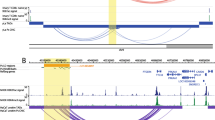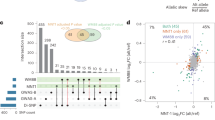Abstract
Skin tumor susceptibility 5 (Skts5) was previously mapped to mouse chromosome 12 through linkage analysis of skin tumor susceptible Mus musculus (NIH/Ola-S) and skin tumor resistant outbred Mus spretus (SPRET/Out-R) mice. Hdac9 was identified as a potential candidate for Skts5 based on conserved non-synonymous sequence variants and expression analyses. Studies by others identified an enhancer in human HDAC9 that correlated with TWIST1 expression. We identified 45 sequence variants between NIH/Ola-S and SPRET/Out-R mice from the orthologous region of the human HDAC9 enhancer. Variants mapping to intron 18 differentially affected luciferase expression in vitro. NIH/Ola-S clones showed an approximate 1.7-fold increased luciferase expression relative to vector alone or the equivalent clones from SPRET/Out-R-R. Furthermore, cells transfected with a portion of the NIH/Ola-S intron induced 2.2-fold increases in Twist1 expression, but the same region from SPRET/Out-R mice resulted in no up-regulation of Twist1. In silico transcription factor analyses identified multiple transcription factors predicted to differentially bind NIH/Ola-S and SPRET/Out-R polymorphic sites. Chromatin immunoprecipitation studies of two transcription factors, Gata3 and Oct1, demonstrated differential binding between NIH/Ola-S and SPRET/Out-R plasmids that corroborated the in silico predictions. Together these studies provide evidence that the murine orthologous region to a human HDAC9 enhancer also acts as a transcriptional enhancer for mouse Twist1. As ectopic sequence variants between NIH/Ola-S and SPRET/Out-R differentially impacted luciferase expression, correlated with Twist1 expression in vitro, and affected Gata3 and Oct1 binding, these variants may explain part of the observed differences in skin tumor susceptibility at Skts5 between NIH/Ola-S and SPRET/Out-R.





Similar content being viewed by others
References
Akiyama Y (1995) TFSEARCH: searching transcription factor binding sites, http://www.rwcp.or.jp/papia/. Accessed 9 June 2014
Angel JM, Caballero M, DiGiovanni J (2003) Identification of novel genetic loci contributing to 12-O-Tetradecanoylphorbol-13-acetate skin tumor promotion susceptibility in DBA/2 and C57BL/6 mice. Cancer Res 63:2747–2751
Ansieau S, Bastid J, Doreau A, Morel AP, Bouchet BP, Thomas C et al (2008) Induction of EMT by twist proteins as a collateral effect of tumor-promoting inactivation of premature senescence. Cancer Cell 14:79–89
Birnbaum RY, Clowney EJ, Agamy O, Kim MJ, Zhao J, Yamanaka T et al (2012) Coding exons function as tissue-specific enhancers of nearby genes. Genome Res 22:1059–1068
Brockschmidt FF, Heilmann S, Ellis JA, Eigelshoven S, Hanneken S, Herold C et al (2011) Susceptibility variants on chromosome 7p21.1 suggest HDAC9 as a new candidate gene for male-pattern baldness. Br J Dermatol 165:1293–1302
Ewart-Toland A, Briassouli P, de Koning JP, Mao JH, Yan J, Chan F et al (2003) Identification of Stk6/STK15 as a candidate low-penetrance tumor-susceptibility gene in mouse and human. Nat Genet 34:403–412
Fleming JL, Dworkin AM, Allain DC, Fernandez S, Wei L, Peters SB et al (2014) Allele-specific imbalance mapping identifies HDAC9 as a candidate gene for cutaneous squamous cell carcinoma. Int J Cancer 134:244–248
Fujiwara K, Igarshi J, Irahara N, Kumura M, Nagase H (2007) New chemically induced skin tumour susceptibility loci identified in a mouse backcross between FVB and dominant resistant PWK. BMC Genet 8:30
Fujiwara K, Wie B, Elliot R, Nagase H (2010) New outbred colony derived from Mus musculus castaneus to identify skin tumor susceptibility loci. Mol Carcinog 49:653–661
Ghosh D (2000) Object-oriented transcription factors database (ooTFD). Nucleic Acids Res 28:308–310
Graham MW, Holton TA (1990) A simple and efficient method for direct cloning of PCR products using ddT-tailed vectors. Nucleic Acids Res 19:1156
Heinemeyer T, Chen X, Karas H, Kel AE, Kel OV, Liebich I et al (1999) Expanding the TRANSFAC database towards an expert system of regulatory molecular mechanisms. Nucleic Acids Res 27:318–322
Hwang-Verslues WW, Chang PH, Jeng YM, Kuo WH, Chiang PH, Chang YC et al (2013) Loss of corepressor PER2 under hypoxia up-regulated OCT1-mediated EMT gene expression and enhances tumor malignancy. Proc Natl Acad Sci USA 110:12331–12336
Jang SI, Karaman-Jurukovska N, Morasso MI, Steinert PM, Markova NG (2000) Complex interactions between epidermal POU domain and activator protein 1 transcription factors regulate the expression of the profilaggrin gene in normal human epidermal keratinocytes. J Biol Chem 275:15295–15304
Kaufman CK, Zhou P, Pasolli HA, Rendl M, Bolotin D, Lim KC et al (2003) GATA-3: an unexpected regulator of cell lineage determination in skin. Genes Dev 17:2108–2122
Kotian S, Liyanarachchi S, Zelent A, Parvin JD (2011) Histone deacetylases 9 and 10 are required for homologous recombination. J Biol Chem 286:7722–7726
Kurek D, Garinis GA, van Doorninck JH, van der Wees J, Grosveld FG (2007) Transcriptome and phenotypic analysis reveal Gata3-dependent signaling pathways in murine hair follicles. Development 134:261–272
Laird PW, Zijderveld A, Linders K, Rudnicki MA, Jaenisch R, Burns A (1991) Simplified mammalian DNA isolation procedure. Nucleic Acids Res 19:4293
Maestro R, Dei Tos AP, Hamamori Y, Krasnokutsky S, Sartorelli V, Kedes L et al (1999) Twist is a potential oncogene that inhibits apoptosis. Genes Dev 13:2207–2217
Mahler KL, Fleming JL, Dworkin AM, Gladman N, Cho HY, Mao JH et al (2008) Sequence divergence of Mus spretus and Mus musculus across a skin cancer susceptibility locus. BMC Genom 9:1–12
Majima Y, Hirakawa S, Kito Y, Suzuki H, Koide M, Fukamizu H et al (2012) Twist1 as a possible biomarker for metastatic basal cell carcinoma. Acta Derm Venereol 92:621–622
Mani SA, Guo W, Liao MJ, Eaton EN, Ayyanan A, Zhou AY et al (2008) The epithelial-mesenchymal transition generates cells with properties of stem cells. Cell 133:704–715
Masse I, Barbollat-Boutrand L, Kharbili ME, Berthier-Vergnes O, Aubert D, Lamartine J (2014) GATA3 inhibits proliferation and induces expression of both early and late differentiation markers in keratinocytes of the human epidermis. Arch Dermatol Res 306:201–208
Maurano MT, Humbert R, Rynes E, Thurman RE, Haugen E, Wang H, Reynolds AP, Sandstrom R et al (2012) Systemic localization of common disease-associated variation in regulatory DNA. Science 337:1190–1195
Mironchik Y, Winnard PT Jr, Vesuna F, Kato Y, Wildes F, Pathak AP et al (2005) Twist overexpression induces in vivo angiogenesis and correlated with chromosomal instability in breast cancer. Cancer Res 65:10801–10809
Nagase H, Bryson S, Cordell H, Kemp CJ, Fee F, Balmain A (1995) Distinct genetic loci control development of benign and malignant skin tumors in mice. Nat Genet 10:424–429
Nica AC, Montgomery SB, Dimas AS, Stranger BE, Beazley C, Barroso I et al (2010) Candidate causal regulatory effects by integration of expression QTLs with complex trait genetic associations. PLoS Genet 6:e1000895
Okumura K, Sato M, Saito M, Miura I, Wakana S, Mao JH et al (2012) Independent geneticcontrol of early and late stages of chemically induced skin tumors in a cross of a Japanese wild-derived inbred mouse strain, MSM/Ms. Carcinogenesis 33:2260–2268
Parker SC, Stitzel ML, Taylor DL, Orozco JM, Erdos MR, Akiyama JA et al (2013) Chromatin stretch enhancer states drive cell-specific gene regulation and harbor human disease risk variants. Proc Natl Acad Sci USA 110:17921–17924
Parra M (2015) Class IIa HDACs- new insights into their functions in physiology and pathology. FEBS J 282:1736–1744
Qin Q, XuY He T, Qin C, Xu J (2012) Normal and disease-related biological functions of Twist1 and underlying molecular mechanisms. Cell Res 22:90–106
Riker A, Enkemann SA, Fodstad O, Liu S, Ren S, Morris C et al (2008) The gene expression profiles of primary and metastatic melanoma yields a transition point of tumor progression and metastasis. BMC Med Genomics 1:13
Shakya A, Kang J, Chumley J, Williams MA, Tantin D (2011) Oct1 is a switchable, bipotential stabilizer of repressed and inducible transcriptional states. J Biol Chem 286:450–459
Skeeles LE, Fleming JL, Mahler KL, Toland AE (2013) The impact of 3′UTR variants on differential expression of candidate cancer susceptibility genes. PLoS ONE 8:e58609
Srivastava J, Rho O, Youssef RM, DiGiovanni J (2015) Twist1 regulates keratinocyte proliferation and skin tumor promotion. Mol Carcinog. doi:10.1002/mc.22335
Sturm RA, Thomson JA, Parsons PG (1993) In vivo and in vitro expression of octamer binding proteins in human melanoma metastasis, brain tissue and fibroblasts. Pigment Cell Res 6:13–22
Su MY, Steiner LA, Bogardus H, Mishra T, Schulz VP, Hardison RC et al (2013) Identification of biologically relevant enhancers in human erythroid cells. J Biol Chem 288:8433–8444
Tsai JH, Donaher JL, Murphy DA, Chau S, Yang J (2012) Spatiotemporal regulation of epithelial-mesenchymal transition is essential for squamous cell carcinoma metastasis. Cancer Cell 22:725–736
Weiss MB, Abel EV, Mayberry MM, Basile KJ, Berger AC, Aplin AE (2012) TWIST1 is an ERK1/2 effector that promotes invasion and regulates MMP-1 expression in human melanoma cells. Cancer Res 72:6382–6392
Wilson D, Charoensawan V, Kummerfeld SK, Teichmann SA (2008) DBD-taxonomically broad transcription factor predictions: new content and functionality. Nucleic Acids Res 36:D88–D92
Zoumpourlis V, Solakidi S, Papathoma A, Papaevangeliou D (2003) Alterations in signal transduction pathways implicated in tumour progression during multistage mouse skin carcinogenesis. Carcinogenesis 24:1159–1165
Acknowledgments
We thank the Parvin laboratory for use of their Fisher Scientific Sonic Dismembrator Model 500. The OSU Comprehensive Cancer Center Nucleic Acids Shared Resource provided support for Sanger Sequencing and qPCR. This work was supported in part by the National Institutes of Health (1R01 CA134461-01), the American Cancer Society (RSG-07-083-1-MGO), and the OSU Comprehensive Cancer Center. TES was supported by a Pelotonia Undergraduate Research Fellowship, and MMG was supported by a Pelotonia Graduate Research Fellowship.
Author information
Authors and Affiliations
Corresponding author
Ethics declarations
Conflict of interest
The authors declare that they have no conflict of interest.
Electronic supplementary material
Below is the link to the electronic supplementary material.
Rights and permissions
About this article
Cite this article
Siekmann, T.E., Gerber, M.M. & Toland, A.E. Variants in an Hdac9 intronic enhancer plasmid impact Twist1 expression in vitro. Mamm Genome 27, 99–110 (2016). https://doi.org/10.1007/s00335-015-9618-3
Received:
Accepted:
Published:
Issue Date:
DOI: https://doi.org/10.1007/s00335-015-9618-3




